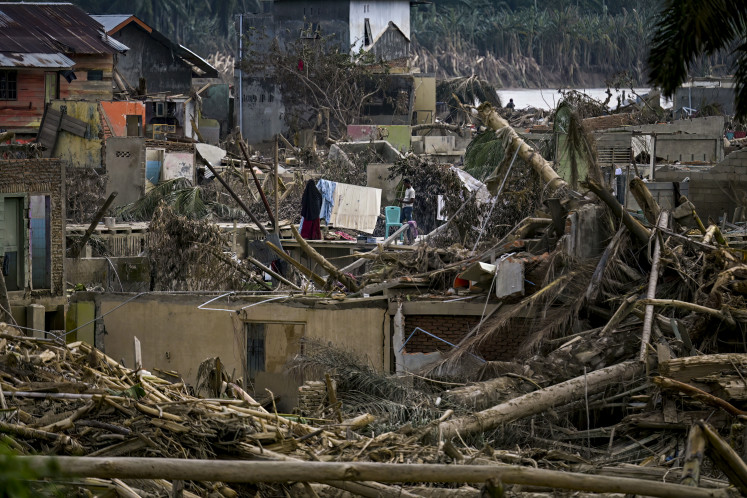Popular Reads
Top Results
Can't find what you're looking for?
View all search resultsPopular Reads
Top Results
Can't find what you're looking for?
View all search resultsLessons from North Asia to overcome pandemic
As many ask, why have the cases and mortalities been higher in the Northern hemisphere among developed countries with generally better health systems than in the South? Is winter a factor? Yet North Asia is also in winter and many countries in the South and along the equator also have COVID-19 cases, although with lower prevalence.
Change text size
Gift Premium Articles
to Anyone
 Breathe for me: Nurse Leah Silver cares for a patient in the COVID-19 ICU at the University of Washington Medical Center, Montlake, on Friday, during the COVID-19 outbreak in Seattle, Washington. The United States has been hit particularly hard by the pandemic as evident in the number of cases and mortalities. (REUTERS/David Ryder)
Breathe for me: Nurse Leah Silver cares for a patient in the COVID-19 ICU at the University of Washington Medical Center, Montlake, on Friday, during the COVID-19 outbreak in Seattle, Washington. The United States has been hit particularly hard by the pandemic as evident in the number of cases and mortalities. (REUTERS/David Ryder)
B
y April 26, the number of COVID-19 cases around the world is nearing 3 million since the first case was reported in Wuhan, China, according to Worldometer data. Deaths due to the SARS-CoV-2 virus in the United States alone exceeded 54,000 from more than 203,000 globally.
Until recently, European and Northern American countries share more than 80 percent of total cases and account for 88 percent of the global death toll and counting, although they share just 28.5 percent of the world population.
As many ask, why have the cases and mortalities been higher in the Northern hemisphere among developed countries with generally better health systems than in the South? Is winter a factor? Yet North Asia is also in winter and many countries in the South and along the equator also have COVID-19 cases, although with lower prevalence.
Read also: Work smart, travel alone, eat out fast: South Korea's prescription for coronavirus recover
Another hypothesis looks at the elderly. The joint report of China and the World Health Organization demonstrate that mortality rates among people above 50 years was six to 20 times higher compared to that for younger age groups.
However, the correlation between COVID-19 mortality and the median age of countries is not convincing. Japan, with a median age of 48 years, has only 0.8 deaths per one million people, Germany with a median age of 46 has 36 deaths per million people, and China with 38 as the median age has two deaths per million people.
In contrast, Italy with a median age of 47 has 329 deaths per million, Spain with 45 years has 368 per million and the United States with a median age of 38 has 66 deaths per million. So, what factors affect high prevalence of COVID-19 and high mortality? Are these factors the response of the health system, the health seeking behavior or risk taking behavior of the people in those countries?
Knowing the main factors of the prevalence of infection and its mortality rates before vaccines or drugs are found would help countries to reduce the cases, deaths and severe economic impacts. It may take months or years to discover the vaccines or drugs while a global recession is looming. All countries affected are taking fairly bold measures to curb the pandemic by full or partial lockdowns. And even countries with comparatively good health systems such as the US, United Kingdom, Italy and Spain are struggling with the pandemic.
Some hypothesize that people in the tropics have lower risks of contracting COVID-19, as the virus is known to flourish in cold weather. So far prevalence rates are relatively low in Indonesia and in neighboring countries including Australia, and also in Brazil and in Africa. However, the pandemic has not reached its global peak.
Read also: Could the new coronavirus weaken 'anti-vaxxers'?
A century ago, the Spanish flu, which killed more than 50 million people, reportedly lasted about three years. The current pandemic is likely still in the early stages, unless vaccines or drugs are discovered soon or a significant proportion of people develop adequate immunity. Then the pandemic would become endemic in some countries.
Studies have found COVID-19 spreads through droplets among humans in close contact. Thus, high mobility of people, mass transportation, economic and recreational activities create huge barriers to curb the virus while communication and information technology enables the swift spread of both good and bad, true and false information.
Despite knowledge about the virus, reckless behavior has increasingly burdened health systems. Essentially, the spread of the disease can be stopped if everyone on Earth constantly keeps a distance of more than 2 meters from each other for at least 14 consecutive days. But this means stopping the wheels of economies and governments for at least for two weeks, which is impossible.
So, is it too late to stop the pandemic? China, South Korea, Japan and also Vietnam show slow growth of COVID-19. Even if the data may be hidden or cases undetected, the virus will continue to spread unless people behave appropriately.
Indonesia may still be lucky or may not reach the peak of COVID-19, though the numbers are still growing – with 23 cases and two deaths (23/2) per million people as of April 19. Cases are much lower compared to China (57/3), South Korea (208/5), Japan (81/2), Spain (4,158/441), the US (2,232/118), and in many other developed countries. The prevalence of COVID-19 in China, South Korea and Japan is decreasing, providing hope more cases can be prevented.
For Indonesia, preventing new cases and mortalities is much more important given the buckling healthcare system. The current high mortality rate in Indonesia, reaching 9.4 percent of total cases, exceeds the world mortality rate of 6.1 percent. This is likely due to late arrivals at the hospital, lack of hospital capacity or other factors. However, mortality rates in Indonesia and in the world are inconclusive because the pandemic is still progressing.
Read also: Indonesia's latest official COVID-19 figures
In preventing new cases, Indonesia’s biggest challenges are poor discipline in keeping physical distance, poor law enforcement and the overall inadequate infrastructure. Throughout the world, people lack discipline, unless local culture and their governments can force them to comply with physical distancing requirements. Will “large-scale social restrictions” succeed? It is a big gamble.
Lessons from some North Asian countries show that discipline, both natural and imposed, works better to control the disease, regardless of whether a full or partial lockdown is imposed.
***
Former dean, School of Public Health, University of Indonesia (UI). This is a personal view.








